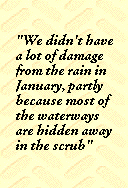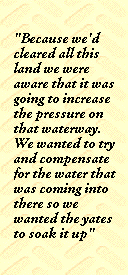
Ken and Madeleine Norman bought their 2037 hectare conditional purchase block to the north of Ravensthorpe in 1983. At that time the block was allocated on the basis of them formulating and submitting an acceptable plan for its development. "When we applied for the farm we had to submit a development plan, which was accepted. Of course we didn't really know what was on the farm, apart from what we saw on aerial photographs, because it was all still bush. We based our plan on the waterways, everywhere there was a drainage line we made it a paddock boundary and left the scrub in them". The main waterway is the Woodenup Creek, which runs in a southwesterly direction into the Jerdacuttup River. Four of its tributaries arise in the property and exit along the southern boundary. The vegetation along the waterways consists of mallee over a heath understorey on the smaller creeks and yate woodland with a melaleuca and sedge understorey on the main creekline. Most of the riparian vegetation was left intact and fenced to exclude stock during the first years of development.
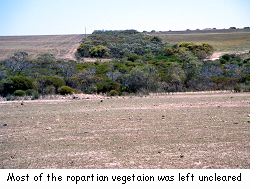 Ken believes that the plan has been largely successful and is happy with the results. A good measure of the success of protecting waterways from the outset of the farm development became evident in early January 2000 when the Ravensthorpe area received 293 mm. of rainfall over two consecutive weekends (90% of the annual average rainfall). "We didn't have a lot of damage from the rain in January, partly because most of the waterways are hidden away in the scrub". The Normans won a New Land Development Award that was sponsored by the Wagin Woolorama in 1986. In 1994 they won the Primary Producer section of the State's John Tonkin Greening Australia Award.
Ken believes that the plan has been largely successful and is happy with the results. A good measure of the success of protecting waterways from the outset of the farm development became evident in early January 2000 when the Ravensthorpe area received 293 mm. of rainfall over two consecutive weekends (90% of the annual average rainfall). "We didn't have a lot of damage from the rain in January, partly because most of the waterways are hidden away in the scrub". The Normans won a New Land Development Award that was sponsored by the Wagin Woolorama in 1986. In 1994 they won the Primary Producer section of the State's John Tonkin Greening Australia Award.
The Problem
Since development of the farm a few problems have become evident such as increasing salinity of the Woodenup Creek. "The salt is creeping down and there are some rocky dykes that are holding up the water and causing a salt problem. The salt was there originally but it's getting a little bit bigger. It's mainly coming down from the neighbouring farm, that is the headwaters of the Woodenup Creek".
Some erosion of the paddocks has also occurred, "When it was new land it was particularly vulnerable to erosion. We had some really wet years in the mid-eighties and some terrible gutters [formed]".
The Solution
The Woodenup/Moolyall Catchment Group has recently been successful in obtaining funds through the Natural Heritage Trust for tree planting and fencing of the upper catchment area of the Woodenup Creek. This work will continue over two years and the Normans hope that it will decrease the upslope discharge that flows into their section of the creek.
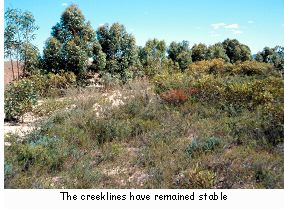 In about 1986 the Normans planted trees alongside the native vegetation corridor of the Woodenup Creek. "Because we'd cleared all this land we were aware that it was going to increase the pressure on that waterway. We wanted to try and compensate for the water that was coming into there so we wanted the yates to soak it up". Ken is pleased with the success of the trees and as far as erosion goes, the creekline has remained stable. However, he has found that the water recharge from higher up in the catchment has caused a decline in the health of some of the native vegetation in the creek despite planting the yates there. He thinks this is due to a rocky dyke that is visible across parts of the creek. He is not sure what steps to take to fix the problem but is thinking about increasing the width of the riparian corridor and planting more trees to use up the excess water.
In about 1986 the Normans planted trees alongside the native vegetation corridor of the Woodenup Creek. "Because we'd cleared all this land we were aware that it was going to increase the pressure on that waterway. We wanted to try and compensate for the water that was coming into there so we wanted the yates to soak it up". Ken is pleased with the success of the trees and as far as erosion goes, the creekline has remained stable. However, he has found that the water recharge from higher up in the catchment has caused a decline in the health of some of the native vegetation in the creek despite planting the yates there. He thinks this is due to a rocky dyke that is visible across parts of the creek. He is not sure what steps to take to fix the problem but is thinking about increasing the width of the riparian corridor and planting more trees to use up the excess water.
Ken has received four Remnant Vegetation Protection Scheme (RVPS) grants from Agriculture Western Australia and a grant from the Water and Rivers Commission to complete the fencing of remnant vegetation that had remained unfenced after clearing. Some of these areas now have a 30-year restrictive covenant on them to prohibit future disturbance.
"Some of the remnant corridors that weren't cleared were left unfenced and there wasn't much understorey in there. About three to four years ago we had a remnant vegetation grant and we fenced them out and they are definitely coming back, you would hardly know that there was stock in some of them now. The poison has also come back vigorously since fencing and you wouldn't want to put stock back there again now".
Since 1985 Ken and Madeleine have established a system of contour banks across the farm. These were originally constructed using a plough and will be maintained in the future with a grader. The water is directed from the contour banks into the vegetated waterways.
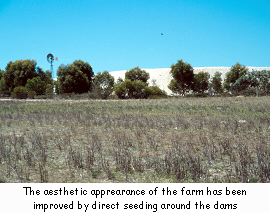 They have also been improving the aesthetic appearance of the farm by direct seeding on one of the contour banks and also around one of the dams. They did this "so it's not a great big white thing stuck there and we also thought that it might make a nice environment for the birds and things. In the latter few years we have thought that the natural vegetation itself wasn't aesthetically pleasing so in the last few years we've planted trees up and down each side of the waterway. So now you've got the natural vegetation in the middle and planted trees along the outside. That's coming along quite nicely. We've done that on three corridors". They have also direct seeded yate trees along the edge of some of the natural vegetation corridors as they wanted taller trees on the farm.
They have also been improving the aesthetic appearance of the farm by direct seeding on one of the contour banks and also around one of the dams. They did this "so it's not a great big white thing stuck there and we also thought that it might make a nice environment for the birds and things. In the latter few years we have thought that the natural vegetation itself wasn't aesthetically pleasing so in the last few years we've planted trees up and down each side of the waterway. So now you've got the natural vegetation in the middle and planted trees along the outside. That's coming along quite nicely. We've done that on three corridors". They have also direct seeded yate trees along the edge of some of the natural vegetation corridors as they wanted taller trees on the farm.
A few corridors were chained and burnt during the development phase and these have all since regrown. Direct seeding has been carried out along the edges of these corridors to increase their width. All the direct seeding and tree planting has been done using local native species. Ken sought expert information and purchased a good "shotgun" mixture of various eucalypts with Acacia picnantha, Casuarina cristata, A. huegeliana, Calothamnus rupestris and Melaleuca coccinea. Tagasaste was also included in the mix in some areas.
The Outcomes and Observations
Ken has noticed that there has been some weed invasion into the riparian corridors but apart from that they haven't changed much over the past 15 years.
Ken believes that he should have made the corridors wider and intends to widen some of them at a later stage. The corridors vary in width from 20 to 50 metres. He says, "I must admit I got more generous as I went on. I said to myself after two or three years that it was not enough. At the time it seemed like I was losing a lot of land and then a few years later I regretted not making them wider".
Ken has observed that after direct seeding, "In the first year not all of the trees came up and then they've been coming up ever since. With direct seeding they often tend to come up later and I wouldn't get despondent if they don't all come up within six months or even a year after you've seeded them because, as long as the weeds are kept out, all of a sudden they'll pop up. The wattles seem to come first and then some of the eucalypts come up". They haven't had any problems with rabbits or kangaroos damaging the seedlings.
"Just forcing yourself to do it is the main thing. Also we were lucky we've had all these remnant vegetation grants. And we did it as we went along, if we had to not only replant but also double fence it would be a major undertaking. Most of the things that we've done have been cheap. So it's been a consistent effort, but not necessarily throwing lots and lots of dollars at it".
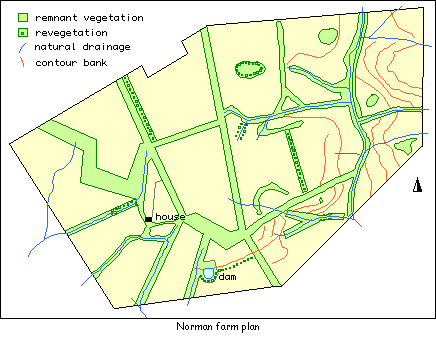
Woodenup Creek Catchment Statistics
| Catchment area: | 5985 hectares | |
| Type of stream: | Ephemeral creek | |
| Average rainfall: | 450 mm./year | |
| Water quality: | Saline | |
| Catchment Disturbances: | Livestock grazing, cropping |
Map Reference: 1:50 000 2929 III
